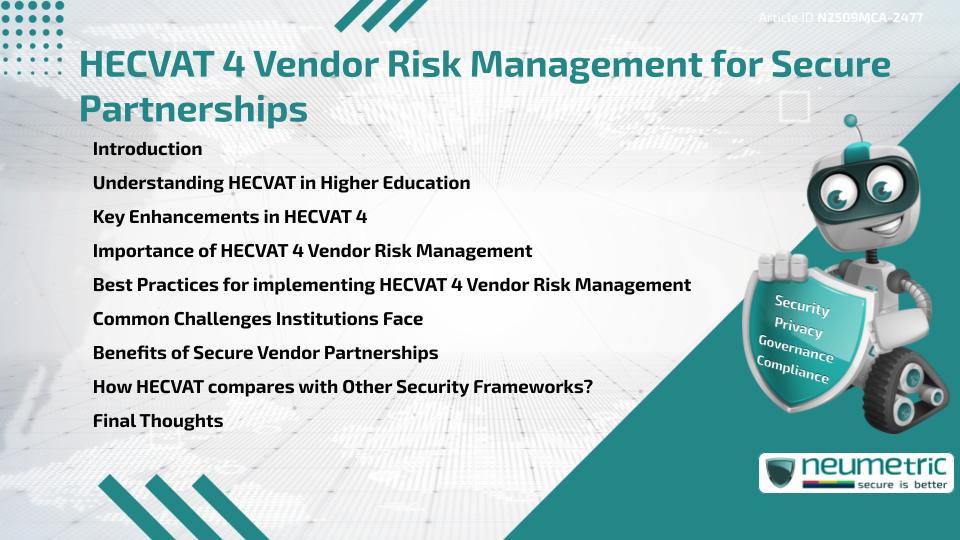Table of Contents
ToggleIntroduction
Higher Education Institutions rely on Third Party Vendors for critical services, ranging from Learning Management Systems to Cloud Storage. These Partnerships bring efficiency but also increase Security Risks. The Higher Education Community Vendor Assessment Toolkit [HECVAT] is designed to assess & manage these Risks. With its latest version, HECVAT 4, Institutions gain refined tools to strengthen oversight. This article explains how HECVAT 4 Vendor Risk Management enables secure Partnerships, improves Compliance & fosters Sector-wide collaboration.
Understanding HECVAT in Higher Education
HECVAT provides a standardised Framework for evaluating Vendors. It was developed specifically for Higher Education to simplify Security Assessments & promote consistency. Instead of each University conducting its own unique evaluation, HECVAT allows Institutions to share Assessments & reduce duplicated efforts. This collective approach benefits both Vendors & Academic Institutions.
Key Enhancements in HECVAT 4
HECVAT 4 introduces clearer structures, improved mapping to Compliance standards & updated categories for Risk evaluation. It also aligns more closely with Privacy Regulations such as FERPA & GDPR, ensuring that Vendor Assessments remain relevant to today’s regulatory landscape. These enhancements provide Institutions with more reliable data when assessing Vendor Security.
Importance of HECVAT 4 Vendor Risk Management
Vendor Partnerships often involve access to sensitive Student & Research Data. Without a structured Risk Management approach, Institutions expose themselves to Breaches, Compliance failures & Reputational harm. HECVAT 4 Vendor Risk Management ensures consistent evaluations that safeguard Institutional data while building trust with Vendors & Stakeholders.
Best Practices for implementing HECVAT 4 Vendor Risk Management
Adopting Best Practices ensures that Institutions maximise the benefits of HECVAT 4:
- Central Oversight: Assign a Governance Team to coordinate Assessments across Departments.
- Vendor Tiering: prioritise Vendors based on their Data Access levels.
- Training Programs: Educate Staff on how to evaluate Responses & manage Results.
- Ongoing Reviews: Regularly revisit Assessments to address evolving Risks.
- Consortium Collaboration: Share completed Assessments with peer Institutions to reduce duplication.
Common Challenges Institutions Face
Despite its effectiveness, implementing HECVAT 4 Vendor Risk Management is not without obstacles. Smaller Colleges may lack the Staff to conduct thorough Assessments & Vendors sometimes hesitate to disclose detailed Security Practices. Additionally, interpreting complex Technical answers can slow down Evaluations.
Benefits of Secure Vendor Partnerships
Institutions that implement HECVAT 4 Vendor Risk Management enjoy improved Compliance with Regulations, stronger protection of Sensitive Information & increased confidence from Students & Faculty. By fostering transparent relationships with Vendors, Universities can form Partnerships built on Trust & Accountability.
How HECVAT compares with Other Security Frameworks?
HECVAT is tailored for Higher Education, unlike broader frameworks such as ISO 27001, NIST CSF or SOC 2. While these frameworks are widely recognised, HECVAT focuses specifically on Academic environments, making it more relevant for Colleges & Universities. However, it can complement these frameworks to provide a well-rounded Risk Management approach.
Final Thoughts
HECVAT 4 Vendor Risk Management provides Higher Education with the tools needed to create Secure & Trustworthy Vendor relationships. By applying structured Best Practices, Universities & Colleges can ensure Data Protection, Compliance & lasting Partnerships.
Takeaways
- HECVAT 4 refines Vendor Risk Assessment for Higher Education.
- Best Practices include Central oversight, Vendor tiering & Staff training.
- Secure Partnerships improve Compliance & build Institutional trust.
FAQ
What is HECVAT 4 Vendor Risk Management?
It is the use of HECVAT 4 to assess & manage Risks from Third Party Vendors in Higher Education.
Why is Vendor Risk Management important for Universities?
It helps protect sensitive Student & Research data, ensures Compliance & prevents Reputational damage.
How do Institutions share HECVAT Assessments?
Through Consortia or Collaborative networks where Universities exchange completed Vendor evaluations.
What challenges occur with HECVAT 4 Vendor Risk Management?
Challenges include limited Staff, Vendor reluctance to disclose details & complex Technical responses.
How does HECVAT differ from ISO 27001 or NIST frameworks?
HECVAT is tailored to the Academic Environment, while ISO 27001 & NIST apply to a wider range of Industries.
Can Small Colleges use HECVAT 4 effectively?
Yes, but they may need to prioritise High-Risk Vendors & rely on shared Assessments to save Time & Resources.
Do Vendors typically accept HECVAT Assessments?
Most Vendors serving Higher Education are familiar with HECVAT & cooperate with the process.
Need help for Security, Privacy, Governance & VAPT?
Neumetric provides organisations the necessary help to achieve their Cybersecurity, Compliance, Governance, Privacy, Certifications & Pentesting needs.
Organisations & Businesses, specifically those which provide SaaS & AI Solutions in the Fintech, BFSI & other regulated sectors, usually need a Cybersecurity Partner for meeting & maintaining the ongoing Security & Privacy needs & requirements of their Enterprise Clients & Privacy conscious Customers.
SOC 2, ISO 27001, ISO 42001, NIST, HIPAA, HECVAT, EU GDPR are some of the Frameworks that are served by Fusion – a SaaS, multimodular, multitenant, centralised, automated, Cybersecurity & Compliance Management system.
Neumetric also provides Expert Services for technical security which covers VAPT for Web Applications, APIs, iOS & Android Mobile Apps, Security Testing for AWS & other Cloud Environments & Cloud Infrastructure & other similar scopes.
Reach out to us by Email or filling out the Contact Form…


